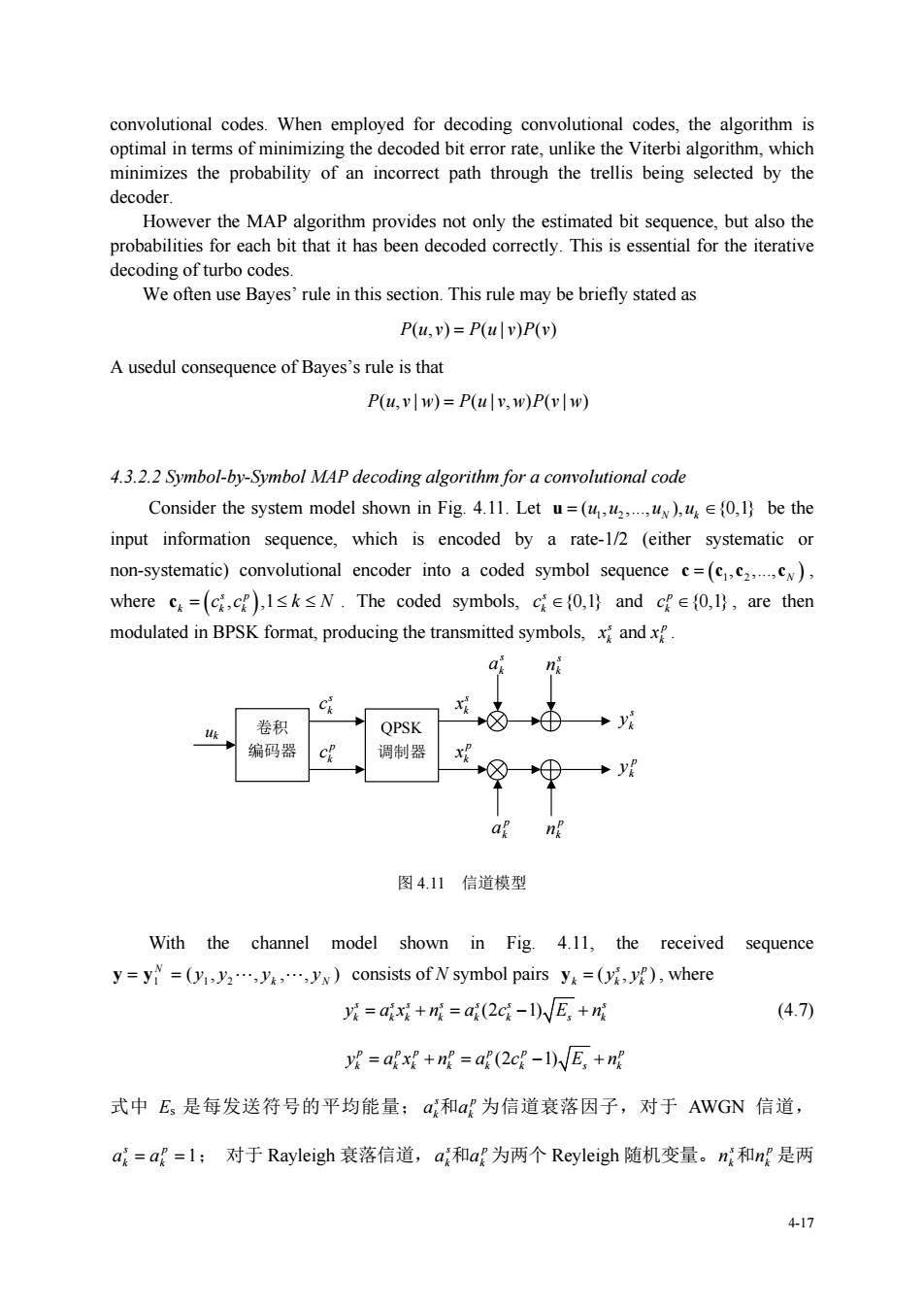正在加载图片...

convolutional codes.When employed for decoding convolutional codes,the algorithm is optimal in terms of minimizing the decoded bit error rate,unlike the Viterbi algorithm,which minimizes the probability of an incorrect path through the trellis being selected by the decoder However the MAP algorithm provides not only the estimated bit sequence.but also the probabilities for each bit that it has been decoded correctly.This is essential for the iterative decoding of turbo codes. we often use Bayes"rule in this section.This rule may be briefly stated as P(u,v)=P(ulv)P(v) A usedul consequence of Bayes's rule is that P(u,vlw)=P(ulv,w)P(vlw) 4.3.2.2 Symbol-by-Symbol MAP decoding algorithm for a convolutional code Consider the system model shown in Fig.4.11.Letu=()be the input information sequence,which is encoded by a rate-1/2 (either systematic or non-systematic)convolutional encoder into a coded symbol sequence c=(c.). where c=(c,cf),l≤k≤N.The coded symbols,.c∈{o,I)and cf∈{0,l,are then modulated in BPSK format,producing the transmitted symbols,andx n 积 ⊕ n 图4.11信道模型 With the channel model shown in Fig.4.11,the received sequence y=y=y,y2.,ya,.,yw)consists of N symbol pairs y=Og,yW),where =+度=ag(2c-)NE+m (4.7) y=ax+=a成(2c-l)WE,+n 式中E是每发送符号的平均能量:a和a为信道衰落因子,对于AWGN信道, a=a{=l;对于Rayleigh衰落信道,a和af为两个Reyleigh随机变量。n和nf是两 417 4-17 convolutional codes. When employed for decoding convolutional codes, the algorithm is optimal in terms of minimizing the decoded bit error rate, unlike the Viterbi algorithm, which minimizes the probability of an incorrect path through the trellis being selected by the decoder. However the MAP algorithm provides not only the estimated bit sequence, but also the probabilities for each bit that it has been decoded correctly. This is essential for the iterative decoding of turbo codes. We often use Bayes’ rule in this section. This rule may be briefly stated as Puv Pu vPv (,) ( | ) () A usedul consequence of Bayes’s rule is that Puv w Pu vwPv w (, | ) ( |, ) (| ) 4.3.2.2 Symbol-by-Symbol MAP decoding algorithm for a convolutional code Consider the system model shown in Fig. 4.11. Let 1 2 ( , ,., ), {0,1} N k u uu u u be the input information sequence, which is encoded by a rate-1/2 (either systematic or non-systematic) convolutional encoder into a coded symbol sequence 1 2 , ,., N c cc c , where , ,1 s p k kk c cc k N . The coded symbols, {0,1} s k c and {0,1} p k c , are then modulated in BPSK format, producing the transmitted symbols, and s p k k x x . 图 4.11 信道模型 With the channel model shown in Fig. 4.11, the received sequence y y 1 12 N k N (, , , ) yy y y consists of N symbol pairs ( , ) s p k kk y y y , where (2 1) s ss s s s s k kk k k k s k y ax n a c E n (4.7) (2 1) p pp p p p p k kk k k k s k y ax n a c E n 式中 Es 是每发送符号的平均能量; p k s ak和a 为信道衰落因子,对于 AWGN 信道, 1 p k s ak a ; 对于 Rayleigh 衰落信道, p k s ak和a 为两个 Reyleigh 随机变量。n n k s k 和 是两 p QPSK 调制器 s k y p k y s ak p ak s nk p nk s k c p k c s k x p k x 卷积 编码器 uk